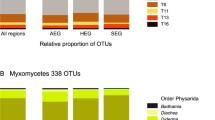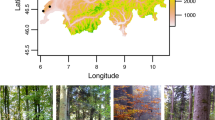Abstract
The social amoebae (dictyostelids) are the only truly multicellular lineage within the superkingdom Amoebozoa, the sister group to Ophistokonts (Metazoa+Fungi). Despite the exceptional phylogenetic and evolutionary value of this taxon, the environmental factors that determine their distribution and diversity are largely unknown. We have applied statistical modeling to a set of data obtained from an extensive and detailed survey in the south-western of Europe (The Iberian Peninsula including Spain and Portugal) in order to estimate some of the main environmental factors influencing the distribution and diversity of dictyostelid in temperate climates. It is the first time that this methodology is applied to the study of this unique group of soil microorganisms. Our results show that a combination of climatic (temperature, water availability), physical (pH) and vegetation (species richness) factors favor dictyostelid species richness. In the Iberian Peninsula, dictyostelid diversity is highest in colder and wet environments, indicating that this group has likely diversified in relatively cold places with high levels of water availability.


Similar content being viewed by others
References
Baldauf SL, Doolittle WF (1997) Origin and evolution of the slime molds (Mycetozoa). Proc Natl Acad Sci USA 94:12007–12012
Baldauf SL, Roger AJ, Wenk-Siefert I, Doolittle WF (2000) A kingdom-level phylogeny of eukariotes based on combined protein data. Science 290:972–977
Bapteste E, Brinkmann H, Lee JA, Moore DV, Sensen CW, Gordon P et al (2002) The analysis of 100 genes supports the grouping of three highly divergent amoebae: Dictyostelium, Entamoeba, and Mastigamoeba. Proc Natl Acad Sci USA 99:1414–1419
Bonner JT (2009) The Social Amoebae: The Biology of Cellular Slime Molds. Princeton Univ. Press, Princeton, N.J., p 156
Cavender JC (1969) The occurrence and distribution of Acrasieae in forest soils I. Europe. Am J Bot 56:989–992
Cavender JC (1969) The occurrence and distribution of Acrasieae in forest soils. II. East Africa. Am J Bot 56:993–998
Cavender JC (1972) Cellular slime molds in forest soils of eastern Canada. Can J Bot 50:1499–1501
Cavender JC, Kawabe K (1989) Cellular slime molds of Japan. I. Distribution and biogeographical considerations. Mycologia 81:683–691
Cavender JC, Raper KB (1965) The Acrasieae in nature. II. Forest soil as a primary habitat. Am J Bot 52:297–302
Cavender JC, Raper KB (1965) The Acrasieae in nature. III. Ocurrence and distribution in forest of Eastern North America. Am J Bot 52:302–308
Cavender JC, Raper KB (1968) The ocurrence and distribution of Acrasieae in forests of subtropical and tropical America. Am J Bot 55:504–513
Cavender JC, Cavender-Bares J, Hohl HR (1995) Ecological distribution of slime molds in forest soils of Germany. Bot Helv 105:199–219
Cook RD, Croos-Dabrera R (1998) Partial residual plots in generalized linear models. J Am Stat Assoc 93:730–739
Fierer N, Jackson RB (2006) The diversity and biogeography of soil bacterial communities. Proc Natl Acad Sci USA 103:626–631
Fiore-Donno AM, Nikolaev SI, Nelson M, Pawlowski J, Cavalier-Smith T, Baldauf SL (2010) Deep Phylogeny and evolution of slime moulds (Mycetozoa). Protist 161:55–70
Hagiwara H (1989) The taxonomic study of Japanese dictyostelid cellular slime molds. National Science Museum, Tokyo
Hillebrand H (2004) On the generality of the latitudinal diversity gradient. Am Nat 163:192–211
Hunter MD, Price PW (1992) Playing chutes and ladders: heterogeneity and the relative roles of bottom-up and top-down forces in natural communities. Ecology 73:724–732
Ionescu M, Beranova K, Dudkova V, Kochankova L, Demnerova K, Macek T, Mackova M (2009) Isolation and characterization of different plant associated bacteria and their potential. Int Biodeterior Biodegradation 63:667–672
Keeling PJ, Doolittle WF (1996) Alpha-tubulin from early-diverging eukaryotic lineages and the evolution of the tubulin family. Mol Biol Evol 13:1297–1305
Kessin RH (2001) Dictyostelium: evolution, cell biology, and the development of multicellularity. Cambridge University Press, Cambridge
Lado C (2008) Eumycetozoa.com: nomenclatural database of Eumycetozoa (Myxomycota) (Oct 2007 version). In Bisby FA, Roskov YR, Orrell TM, Nicolson D, Paglinawan LE, Bailly N, Kirk, PM, Bourgoin T, van Hertum J (eds) Species 2000 and ITIS Catalogue of Life: 2008 Annual Checklist CD-ROM. Reading, UK
Landolt JC, Stephenson SL, Slay ME (2006) Dictyostelid cellular slime molds from caves. J Caves Karst Stud 68:22–26
Lauber CL, Hamady M, Knight R, Fierer N (2009) Pyrosequencing-based assessment of soil pH as a predictor of soil bacterial community structure at the continental scale. Appl Environ Microbiol 75:5111–5120
Legendre P (1993) Spatial autocorrelation: trouble or a new paradigm? Ecology 74:1659–1673
Leitner A: Acrasiales in Geschadigtn Waldern. Thesis, Universitat Konstanz, Switzerland (1987)
Lindow SE, Brandl MT (2003) Microbiology of the phyllosphere. Appl Environ Microbiol 69:1875–1883
Lozupone CA, Knight R (2007) Global patterns in bacterial diversity. Proc Natl Acad Sci USA 104:11436–1140
Mittelbach GG, Schemske DW, Cornell HV, Allen AP, Brown JM, Bush MB et al (2007) Evolution and the latitudinal diversity gradient: speciation, extinction and biogeography. Ecol Lett 10:315–331
Moya-Laraño J (2010) Can temperature and water availability contribute to the maintenance of latitudinal diversity by increasing the rate of biotic interactions? The Open Ecology Journal 3:1–13
Moya-Laraño J, Corcobado G (2008) Plotting partial correlation and regression in ecological studies. Web Ecology 8:35–46
Moya-Laraño J, Wise DH (2007) Two simple strategies of analysis to increase the power of experiments with multiple response variables. Basic Appl Ecol 8:398–410
Ninyerola M, Pons X, Roure JM (2005) Atlas Climático Digital de la Península Ibérica. Metodología y aplicaciones en bioclimatología y geobotánica. Universidad Autónoma de Barcelona, Bellaterra. ISBN 932860-8-7
Pearce J, Ferrier S (2001) The practical value of modelling relative abundance of species for regional conservation planning: a case study. Biol Conserv 98:33–43
Raper KB (1984) The Dictyostelids. Princeton University Press, Princeton
R Development Core Team. R: A language and environment for statistical computing. http://www.R-project.org (2009). Vienna, Austria, Accessed April 2010
Ricklefs RE, Schluter D (1993) Species diversity: regional and historical influences. In: Ricklefs RE, Schluter D (eds) Species diversity in ecological communities. Univ. of Chicago Press, Chicago, pp 350–363
Romeralo M, Lado C (2006) Dictyostelids from Mediterranean forests of the south of Europe. Mycol Prog 5:231–241
Romeralo M, Lado C (2008) The biodiversity of Dictyostelids in a Spanish Biosphere Reserve. Nova Hedwig 87:247–259
Romeralo M, Escalante R, Sastre L, Lado C (2007) Molecular systematics of dictyostelids: 5.8S ribosomal DNA and internal transcribed spacer region analyses. Eukaryot Cell 6:110–116
Romeralo M, Cavender JC, Baldauf S (2009) A new species of cellular slime molds from southern Portugal based on morphology ITS and SSU sequences. Mycologia 101:269–274
Rosenzweig ML (1995) Species diversity in space and time. Cambridge Univ. Press, Cambridge
Schaap P, Winckler T, Nelson M, Álvarez-Curto E, Elgie B, Hagiwara H et al (2006) Molecular phylogeny and evolution of morphology in the social amoebas. Science 314:661–663
Schnittler M (2001) Ecology of myxomycetes of a winter-cold desert in western Kazakhstan. Mycologia 93:653–669
Schnittler M, Stephenson SL (2000) Myxomycete biodiversity in four different forest types in Costa Rica. Mycologia 92:626–637
Stechmann A, Cavalier-Smith TC (2003) The root of the eukaryote tree pinpointed. Curr Biol 13:R665–R666
Swanson AR, Vadell EM, Cavender JC (1999) Global distribution of forest soil dictyostelids. J Biogeogr 26:133–148
Traub HP, Hohl HR, Cavender JC (1981) Cellular slime molds of Switzerland. I. Description of new species. Am J Bot 68:162–171
Traub HP, Hohl HR, Cavender JC (1981) Cellular slime molds of Switzerland. II. Distribution in forest soils. Am J Bot 68:172–182
Willig MR, Kaufman DM, Stevens RD (2003) Latitudinal gradients of biodiversity: pattern, process, scale, and synthesis. Ann Rev Ecol Evol Systemat 34:273–309
Yang CH, Crowley DE, Borneman J, Keen NT (2001) Microbial phyllosphere populations are more complex than previously realized. Proc Nat Acad Sci USA 98:3889–3894
Yergeau E, Bezemer TM, Hedlund K, Mortimer SR, Kowalchuk GA, van der Putten WH (Published online: Sept. 16, 2009) Influences of space, soil nematodes and plants on microbial community composition of chalk grassland soils. Environ Microbiol (in press)
Acknowledgements
We want to thank María Aguilar (Royal Botanical Garden, Madrid) for the help with the species accumulation curve and Allison Perrigo (EBC, Uppsala University, Sweden) for the linguistic assistance. This research was supported by a postdoctoral fellowship from the Ministry of Science and Innovation of Spain (0027-2007) to M. Romeralo, with funding also coming from the project CGL2005-00320/BOS and CGL2008-0720/BOS of this Ministry.
Author information
Authors and Affiliations
Corresponding author
Rights and permissions
About this article
Cite this article
Romeralo, M., Moya-Laraño, J. & Lado, C. Social Amoebae: Environmental Factors Influencing Their Distribution and Diversity Across South-Western Europe. Microb Ecol 61, 154–165 (2011). https://doi.org/10.1007/s00248-010-9715-5
Received:
Accepted:
Published:
Issue Date:
DOI: https://doi.org/10.1007/s00248-010-9715-5




